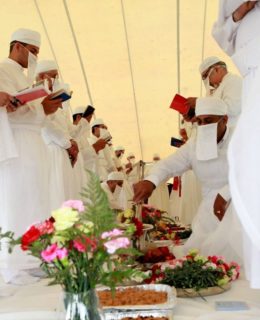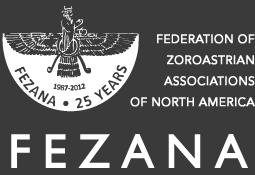Pathaamchaa vîcharanaao yazamaide, Pathaamchaa hanjamanaao yazamaidé.
We revere the forking of the roads, And we revere the coming together of the roads.
[Yasna Ha 42.1 – From the Haptanghaaiti]
We learned of the wisdom of the ancient Indo-Iranian tradition of reverence for “ hanjamanaao”, the divergence and the confluence of rivers and roads, at the 10th World Zoroastrian Congress in Mumbai (1,2,3,4) . The point made by Mobed Mehraban Firouzgary is that Hanja Mana has to do not only with rivers and roads but with human interactions in building relationships (5).
 “Our community members and leaders need to attach similar piety and reverence, to the elected management committee bodies of their anjumans, and vice versa” (italics added) (1).
“Our community members and leaders need to attach similar piety and reverence, to the elected management committee bodies of their anjumans, and vice versa” (italics added) (1).
An important take away: not only should elected leaders be respected, but they in turn should listen carefully to what is being expressed by those at the grassroots. We learnt this lesson from the story of the Great King Jamshed, whom we remember every year at the spring equinox and the loss of his Khavarneh (Glory), when he succumbed to arrogance.
Participation in a respectful dialogue makes for positive outcomes. A thought expressed at an appropriate time and in proper manner can be adopted by another, who brings his/her own unique skills in executing the concept to the advantage of the entire group. A healthy and vibrant governance structure thus created, assures success. Shared below are a few examples, to illustrate how the powerful concept of Hanja Mana (i.e., listening to divergent views with respect) can , with patience, lead to consensus building among likeminded people, creating gifts which keep on giving.
CREATING AWARENESS
A few years ago, a cyber-dialogue was started from California by Mehrborzin Soroushian under the title “CreatingAwareness”. Carefully monitored for content, a vibrant educative exchange, (an electronic Hanja Mana in cyberspace!), grew to over 5000 subscribers worldwide rapidly. Faced with an earthquake in South-East Asia, an introspective e-mail on our possible collective response to such a humanitarian calamity from Dina McIntyre, became a clarion call to action. A warm-clothes collection drive by Zarathushtis from North America drew support from faith traditions other than our own. Consignments of donated woolies were air-lifted to Pakistan, distributed by Toxy Cowasjee and her team to survivors freezing at the foothills of the Himalayas. Listening to one another we came together to work together for a common cause moving us to tap into our better selves.
ZOROASTRIANS STEPPING FORWARD
Other examples abound: The Zoroastrians Stepping Forward initiative, arising from the 5th World Zoroastrian Youth Congress in Vancouver, Canada ended with shoes from Virginia, USA taken to a remote village in Africa (Children of Mtaya) from a collection drive launched by the annual 911 Unity Walk. (photo right)
COMING TOGETHER ROUND TABLE
 An ongoing Zarathushti Cyber-dialogue at Zoroastrians.net, is a legacy of a successful Hanja Mana – the Coming Together Roundtable held at the Athornan Institute at the Dadar Parsi Colony, Mumbai. A suggestion made during a tea-break by Behram Nagarwala from Ahmednagar, Maharashtra, executed brilliantly by Yazdi Tantra from Mumbai, now provides a service for FEZANA Association members and small groups, gratis, to post upcoming events on an electronic calendar with RSS feeds.
An ongoing Zarathushti Cyber-dialogue at Zoroastrians.net, is a legacy of a successful Hanja Mana – the Coming Together Roundtable held at the Athornan Institute at the Dadar Parsi Colony, Mumbai. A suggestion made during a tea-break by Behram Nagarwala from Ahmednagar, Maharashtra, executed brilliantly by Yazdi Tantra from Mumbai, now provides a service for FEZANA Association members and small groups, gratis, to post upcoming events on an electronic calendar with RSS feeds.
RETURN TO ROOTS
 A graduate student in Princeton University, Dinsha Mistree noticed the transformation in his friend who travelled to Israel, to connect with his roots and traditions. Modelled on this idea, we have successfully completed the First Zarathushti Return to Roots program. We hope the legacy perpetuates itself (6). This issue of the Journal showcases a Return to Roots of a different kind. We go back to our ancient past and delve into long lost archeological treasures. Travel is education. Let us enjoy what our scholars have taken the trouble to unearth from our Zarathushti heritage in Central Asia.
A graduate student in Princeton University, Dinsha Mistree noticed the transformation in his friend who travelled to Israel, to connect with his roots and traditions. Modelled on this idea, we have successfully completed the First Zarathushti Return to Roots program. We hope the legacy perpetuates itself (6). This issue of the Journal showcases a Return to Roots of a different kind. We go back to our ancient past and delve into long lost archeological treasures. Travel is education. Let us enjoy what our scholars have taken the trouble to unearth from our Zarathushti heritage in Central Asia.
Our North American Zarathushti team of intrepid explorers plans to return to their roots on the Ancient Silk Road in 2014. We look forward to hearing about their voyage of discovery and share with us stories of Hanja Mana: not only of rivers and roads of Ancient Iran, but of how they envision the evolution of our Zarathushti diaspora on this continent.
May we keep learning from each other and improve ourselves incrementally as we travel together on this short sojourn of life.
Behram Pastakia is the Chair of the Publications Committee of FEZANA
Notes:
1. Mehraban Firouzgary: How Useful are WZC’s ? Parsiana, World Zoroastrian Congress Special Issue: December 2013, page 13.
2. The “H” and the “S” sounds often get transposed linguistically as one travels east from Ancient Iran to the valley of the Indus and beyond. Ahura is transposed to Asura. Hapta Hindu becomes Sapta Sindhu.
3. The town of Sanjan, is by some accounts, a derivative of the word Hanjan, a village where three different classes (not castes) of Zoroastrians priests lived in harmony. हंजiमननगर [Sir J.J. Modi: The Journal of the Bombay Branch of the Royal Asiatic Society, Vol. XXI, 1904 page 14].
4. Sangam (the sacred confluence of rivers on the vast Gangetic plains of Eastern India revered by the Hindus) is very close phonetically to Hangam. We can even construe that the word Anjuman derives from the scriptural reference to HanjaMana.
5. “ If allowed to convey my own, acquired, knowledge of the Subject matter – the Gathic words Hem… Jamaete meaning Assembly / participants as in Yasna 44 (15) has developed derivations like Hanjam = to meet together /meeting point, further into Hanjam Mana = Meeting point of minds / intellects (Mana). With such thoughts in mind I am led to believe that the Patamchaa Hanjamanao, may not indicate, simply, the coming together of the Roads as earthen roads but a junction or meeting place for Intellects who have travelled / crossed different roads / directions to meet for discussions / consultations. Other derivations are: Jamyath as in the Niyayesh “Atha Jamyath Yatha Aafrinamie” (May it turn out as the Participants (here) wish), the Farsi word Jameeat = population & etc.. Derivations of Hanjamana are used in several Yashts, e.g. 10(7), 10(65), 13(16), 13(85), 23(3), 25(61), Yasna 62(5), Vand.22(13) & etc. always preceded by a variation of the word Viakhana meaning Leader /Supervisor.” – Notes from Mobed Mehraban Firouzgary, Tehran, Iran.
6. Sasan Jahanian and Diana Vania: Zoroastrian Return to Roots, Perpetuating the Zarathushti Faith for Future Generations – [Fezana Journal, Vol. 27, No 4, pages 34-37, Winter/December 2013].
The above article first appeared in the Summer 2014 Issue of the FEZANA Journal.
To know more about the Journal and check out the archives click here: http://fezana.org/publication/fj/
To subscribe to the FEZANA Journal click here: https://fezana.org/publication/fj/subscribe/





